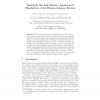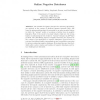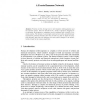ICARIS
2004
Springer
14 years 7 months ago
2004
Springer
The immune system exhibits properties such as learning, distributivity continual adaptation, context dependent response and memory during the lifetime of a host. This paper argues ...
ICARIS
2004
Springer
14 years 7 months ago
2004
Springer
Abstract. We present a swarm-based, 3-dimensional model of the human immune system and its response to first and second viral antigen exposure. Our model utilizes a decentralized ...
ICARIS
2004
Springer
14 years 7 months ago
2004
Springer
The benefits of negative detection for obscuring information are explored in the context of Artificial Immune Systems (AIS). AIS based on string matching have the potential for a...
ICARIS
2004
Springer
14 years 7 months ago
2004
Springer
We investigated a real-valued Negative Selection Algorithm (NSA) for fault detection in man-in-the-loop aircraft operation. The detection algorithm uses body-axes angular rate sens...
ICARIS
2004
Springer
14 years 7 months ago
2004
Springer
We propose that bio-inspired algorithms are best developed and analysed in the context of a multidisciplinary conceptual framework that provides for sophisticated biological models...
ICARIS
2004
Springer
14 years 7 months ago
2004
Springer
Proteins are the driving force in development (embryogenesis) and the immune system. Here we describe how a model of proteins designed for evolutionary development in computers can...
ICARIS
2004
Springer
14 years 7 months ago
2004
Springer
The use of artificial immune systems in intrusion detection is an appealing concept for two reasons. Firstly, the human immune system provides the human body with a high level of ...
ICARIS
2004
Springer
14 years 7 months ago
2004
Springer
MHC molecules, also known in the human as human leukocyte antigens (HLA), display peptides on antigen presenting cell surfaces for subsequent T cell recognition. Identification of ...



